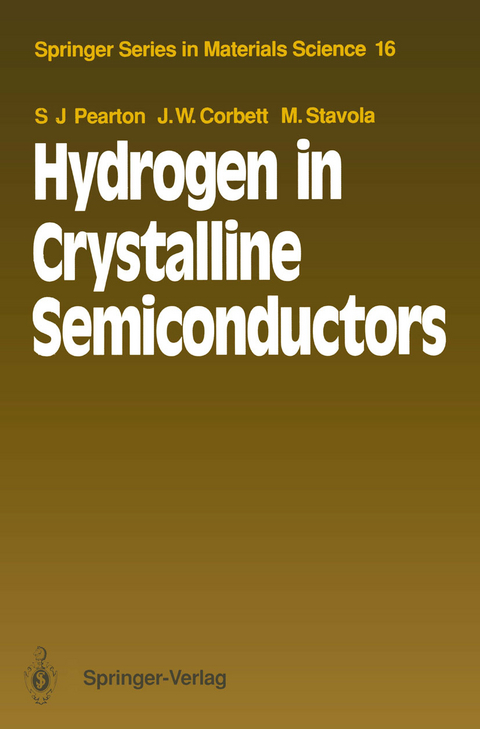
Hydrogen in Crystalline Semiconductors
Springer Berlin (Verlag)
978-3-540-55491-2 (ISBN)
Diese Übersicht über die Eigenschaften von Wasserstoff in kristallinen Halbleitern hebt die verschiedenen Wege hervor, auf denen Wasserstoff während der Kristallisation bzw. Produktion von kristallinen Bauelementen eingebaut wird, einem Gebiet von ungeheurer Bedeutung für die Praxis. Es ist die erste Monographie, die die Eigenschaften von Wasserstoff als Fremdatom im Detail behandelt; sie wird für all jene von Interesse sein, die sich mit der Physik der Bauelemente und der Forschung und Entwicklung von Halbleitern beschäftigen.
This monograph arose out of the recognition of the importance of hydrogen in modern semiconductor technology. Hydrogen is a component of most chemicals used in the fabrication of electronic and photonic devices, is easily incorporated into semiconductors and it is a model impurity for studying defect reactions in solids. While writing this volume we have received a good deal of encourage ment from our colleagues at AT&T Bell Laboratories, State University of New York at Albany and Lehigh University, and from collaborators at other institutions: to them we extend our sincere appreciation. In particular we would like to thank W. e. Dautremont-Smith, J. Lopata, V. Swamina than, K. Bergman, L. e. Synder, P. Deak, J. T. Borenstein, T. S. Shi, D. Tul chinsky, G. G. DeLeo, W. B. Fowler, G. D. Watkins and D. Kozuch for their crucial contributions to this work. We would also like to thank Mrs. Danuta Sowinska-Kahn for her unfailing expertise in preparing much of the art work. Finally we owe a great debt to Helmut Lotsch of Springer-Verlag for his initial suggestion to write this book and then his patient and professional guidance in seeing the project to fruition. Murray Hill, NJ S. J. Pearton Albany, NY J. w. Corbett Bethlehem, P A M. Stavola October 1991 v Contents 1. Introduction . . . . . . . . . . . . . . . . . . . . . . . . . . . . . . 2. Hydrogen Incorporation in Crystalline Semiconductors 4 2. l Techniques for Hydrogen Incorporation in Semiconductors . . . . . . . . . . . . . . . . . . . . . . . 5 2. 1. 1 Hydrogen Plasma Exposure. . . . . . . . . . . . . . . . . . . 5 2. l. 2 Hydrogen Implantation . . . . . . .
1. Introduction.- 2. Hydrogen Incorporation in Crystalline Semiconductors.- 2.1 Techniques for Hydrogen Incorporation in Semiconductors.- 2.2 Survey of the Configurations of Hydrogen in Semiconductors.- 3. Passivation of Deep Levels by Hydrogen.- 3.1 Deep-Level Passivation in Silicon.- 3.2 Passivation of Defects in Gallium Arsenide.- 3.3 Aluminum Gallium Arsenide.- 3.4 Gallium Phosphide.- 3.5 CdHgTe, Zn3P2.- 3.6 Germanium.- 4. Shallow Impurity Passivation by Atomic Hydrogen.- 4.1 Silicon.- 4.2 Gallium Arsenide.- 4.3 AlGaAs.- 4.4 CdTe and ZnTe.- 4.5 Gallium Phosphide.- 4.6 Germanium.- 4.7 Indium Phosphide.- 4.8 BN and BP.- 4.9 Correlation with Muonium.- 5. Microscopic Properties of Hydrogen-Related Complexes in Silicon from Vibrational Spectroscopy.- 5.1 Vibrational Spectroscopy of H-Related Complexes.- 5.2 Uniaxial Stress Studies of H-Related Complexes.- 5.3 Hydrogen Motion in the B-H Complex.- 5.4 Conclusion.- 6. The Microscopic Characteristics of Impurity-Hydrogen Complexes in III-V Semiconductors.- 6.1 Acceptor-H Complexes.- 6.2 Donor-H Complexes.- 6.3 Unintentional Hydrogenation.- 6.4 Uniaxial Stress Studies.- 6.5 Cluster Calculations for H-Related Complexes in GaAs.- 6.6 Conclusion.- 7. Hydrogen, and Semiconductor Surfaces and Surface Layers.- 7.1 Etching of Silicon Surfaces by Hydrogen.- 7.2 Plasma Etching.- 7.3 Implantation of Protons.- 7.4 Hydrogen on Semiconductor Surfaces.- 8. Hydrogen-Related Defects in Semiconductors.- 8.1 Hydrogen-Related Defects in Silicon.- 8.2 Hydrogen-Related Defects in Germanium.- 8.3 Hydrogen-Related Defects in Compound Semiconductors.- 8.4 Hydrogen-Related IR Bands in Silicon.- 9. Diffusion of Hydrogen in Semiconductors.- 9.1 Diffusion of Hydrogen in Solids.- 9.2 Diffusion Equations.- 9.3 Analysis of Diffusion Profiles.- 9.4 Diffusion of Hydrogen in Silicon.- 9.5 Diffusion of Hydrogen in Germanium.- 9.6 Diffusion in Gallium Arsenide.- 9.7 Diffusion of Hydrogen in Other Materials.- 9.8 Summary.- 10. Resonance Studies Pertinent to Hydrogen in Semiconductors.- 10.1 Electron Paramagnetic Resonance.- 10.2 Related Muon Studies.- 10.3 Perturbed Angular Correlation.- 11. Prevalence of Hydrogen Incorporation and Device Applications.- 11.1 Experimental Studies of Hydrogen Incorporation.- 11.2 Hydrogen Sensing with MOS Structures.- 11.3 Hydrogen in III-V Semiconductors.- 12. Hydrogen and the Mechanical Properties of Semiconductors.- 12.1 Hydrogen Embrittlement.- 12.2 Hydrogen-Related Defects.- 12.3 m-V Semiconductors.- References.
| Erscheint lt. Verlag | 29.6.1992 |
|---|---|
| Reihe/Serie | Springer Series in Materials Science |
| Mitarbeit |
Gast Herausgeber: H.-J. Queisser |
| Zusatzinfo | XI, 363 p. |
| Verlagsort | Berlin |
| Sprache | englisch |
| Maße | 155 x 235 mm |
| Gewicht | 496 g |
| Themenwelt | Naturwissenschaften ► Chemie ► Physikalische Chemie |
| Naturwissenschaften ► Physik / Astronomie ► Atom- / Kern- / Molekularphysik | |
| Naturwissenschaften ► Physik / Astronomie ► Festkörperphysik | |
| Naturwissenschaften ► Physik / Astronomie ► Thermodynamik | |
| Technik ► Elektrotechnik / Energietechnik | |
| Schlagworte | deep levels • Halbleiter • Hydrogen • Kristallisation • passivation • spectroscopy • Springer Series in Materials Science; Vol 16 • vibrational spectroscopy • Wasserstoff |
| ISBN-10 | 3-540-55491-2 / 3540554912 |
| ISBN-13 | 978-3-540-55491-2 / 9783540554912 |
| Zustand | Neuware |
| Haben Sie eine Frage zum Produkt? |
aus dem Bereich


